The April unemployment rate remained the same, yet unlike the past few months, the lack of change was not due to people dropping out of the workforce. Instead the participation rate ticked up a smidgen and more people were considered employed. The official unemployment rate is 5.4%, a tenth of a percentage point lower than last month. The labor participation rate ticked up a tenth of a percentage point and is now 62.8%, although the employment to population ratio didn't budge from last month.
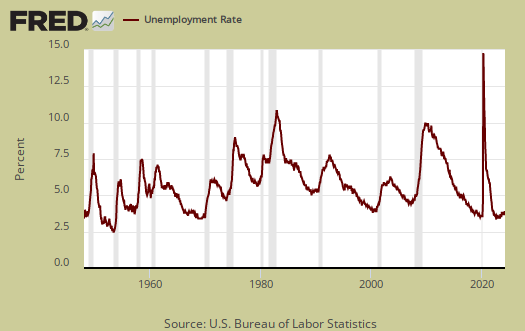
This article overviews and graphs the statistics from the Employment report Household Survey also known as CPS, or current population survey. The CPS survey tells us about people employed, not employed, looking for work and not counted at all. The household survey has large swings on a monthly basis as well as a large margin of sampling error. The CPS has severe limitations, yet, it is our only real insight into what the overall population are doing for work.
Those employed grew by 192,000 this month, a fine showing in comparison to the last few monthly changes. From a year ago, the employed has increased by 2.8 million, well beyond what is needed to keep up with increased population growth.
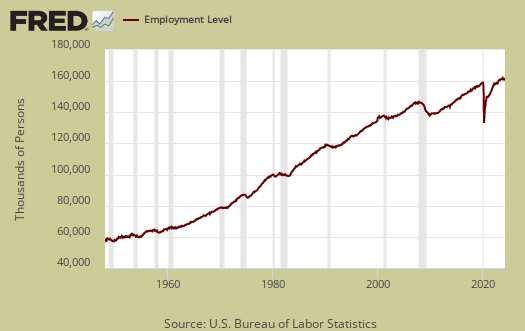
Those unemployed decreased by -26,000 to stand at 8,549,000. From a year ago the unemployed has decreased by -1.15 million. Below is the month change in unemployed and as we can see, this number normally swings wildly on a month to month basis.
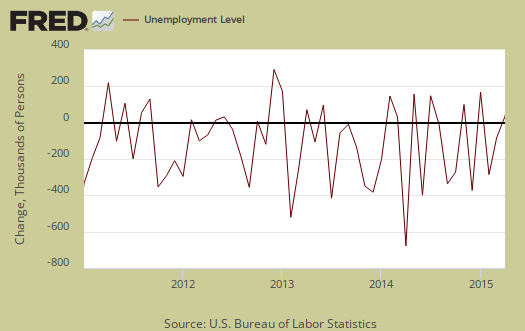
Those not in the labor force increased by 19,000 to 93,194,000. The below graph is the monthly change of the not in the labor force ranks. Those not in the labor force has increased by 1,175,000 in the past year.

The labor participation rate is at 62.8%, a 0.1 change from last month and a rebound to February's rate. Those aged 16 and over either working or looking for work is still at record lows, as shown in the below graph.

The low labor participation rate is not all baby boomers and people entering into retirement. Below is a graph of the labor participation rate for those between the ages of 25 to 54. These are the prime working years, so one cannot blame retirement and college on the declining participation rate. The 25 to 54 age bracket labor participation rates have not been this low since the 1980's recession and the rate stands at 81%, the same rate as February.

The civilian labor force, which consists of the employed and the officially unemployed, increased by 166 thousand this month. The civilian labor force has grown by 1,652,000 over the past year. New workers enter the labor force every day from increased population inside the United States and immigration, both legal and illegal.
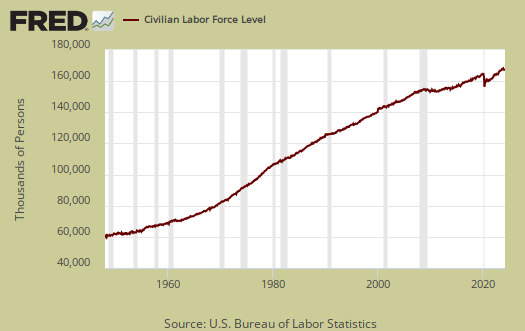
In spite of wild statistical swings, those not in the labor force often grows faster than the population which has the potential to work. Below is a graph of those not in the labor force, (maroon, scale on the left), against the noninstitutional civilian population (blue, scale on the right). Notice how those not in the labor force crosses the noninstitutional civilian population in growth and the accelerated growth started happening right in 2008. The increase cannot be explained by retiring baby boomers alone.
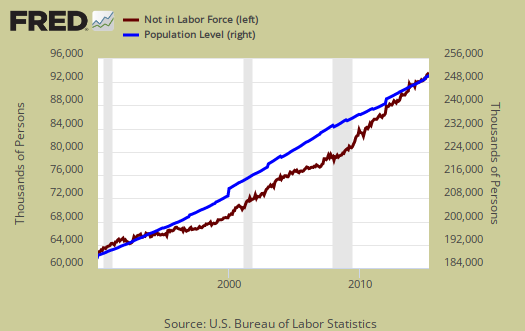
Below is a graph of the civilian labor force, or the official employed plus unemployed, in maroon, scale on left, against those not in the labor force, in blue, scale on right. Notice how those not in the labor force as a trend exceeded those considered employed and unemployed starting around mid 2009. The never ending growing segment of the population that is considered neither employed or unemployed, is above the trend line of those who would be naturally dropping out, such as the retired and those in school. Not in the labor force figures do include retirees and the size of the population greater than age 65 has grown.
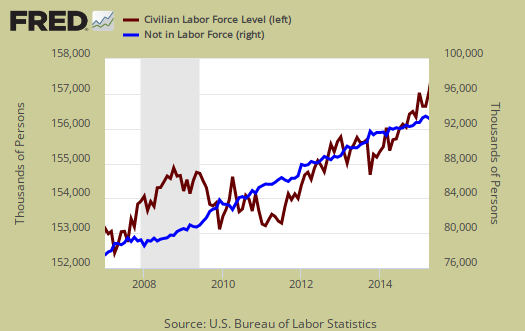
Those considered employed as a ratio to the total Civilian noninstitutional population now stands at 59.3%, which is more no change for the last four months. The relationship between the employment-population ratio and the labor participation rate (LPR) is: employment-population ratio = LPR * (1 - unemployment rate).

Part-time for economic reasons dropped -125 thousand for the month. Those forced into part time work stands at 6,580,000 people. There are still millions of people who need full-time jobs with benefits who simply can't get them. This month's decrease is another good sign.
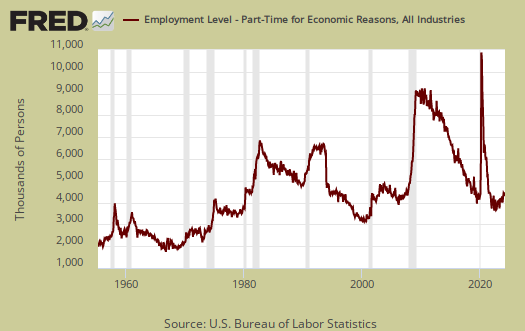
There are two categories of those forced into part-time jobs due to economic circumstances. Those who could only get part-time jobs and those already working who got their hours cut due to businesses not having enough work for them. The number of people who could only get part-time work increased by 37 thousand to 2,374,,000 as shown below.

People can also work part-time hours due to slack business demand. People who got their hours cut due to slack working conditions decreased by -184,000 and stands at 3,885,000. Below is a graph of forced into part-time work because they got their hours cut, as a percentage of the total employed. This is a recession economic indicator, notice how the line slope matches strongly the graph gray recession bars in the below graph.
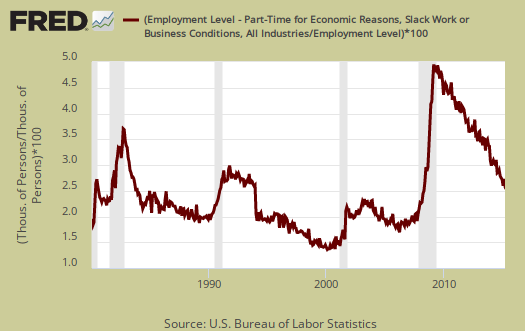
U-6 now stands at 10.8%. U-6 is a broader measure of unemployment and includes the official unemployed, people working part-time hours because that's all they can get and a subgroup not counted in the labor force but are available for work and looked in the last 12 months. The U-6 rate still leaves out some people wanting a job who are not considered part of the labor force.
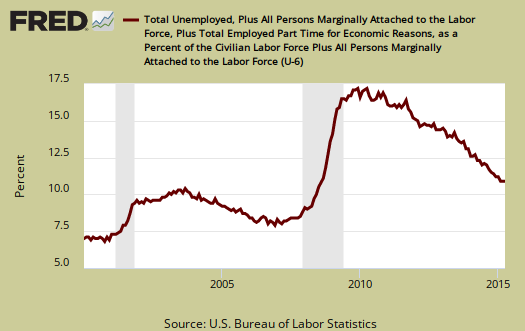
The long term unemployed, or those unemployed for 27 weeks and over, dropped by -38,000 to stand at 2,525,000 people. From a year ago the long term unemployed ranks has declined 26%, but this does not mean at all became employed. Some must be dropped out of the count, as evidenced by the record high not in the labor force figures.
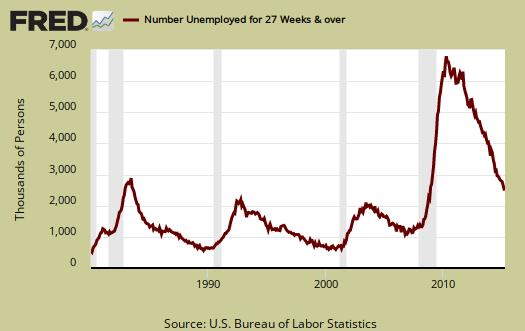
Within the CPS survey is how many people who are considered not in the labor force who report they want a job now. It is a direct survey question. The Census asks people who are not being counted in the unemployment statistics and official unemployment rate if they want a job. The number who answer yes currently stands at 6,258,000, a very large number of people. Those who are not counted yet report they want a job includes the discouraged workers and marginally attached and is seasonally adjusted. This figure has barely budged from a year ago and although decreased -111,000 from last month. This figure should drop along with the unemployment rate so seeing a monthly decline might be a sign of better news, although one month does not a trend make in labor statistics.
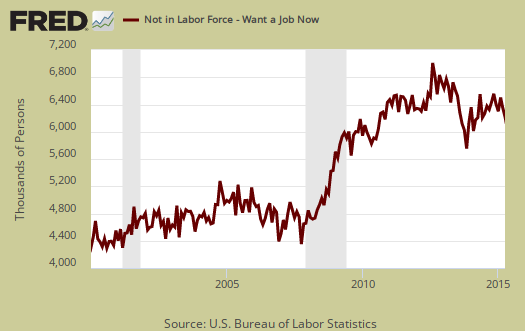
The average length of unemployment is 30.8 weeks and a year ago was 34.8 weeks. Even with a month drop from a year ago, that's still a very long time to be without a paycheck. Also the average time to be unemployed is so out of line with the median due to the long term unemployed. Dumping off large swaths of workers and refusing to rehire them has become business as usual to this day.
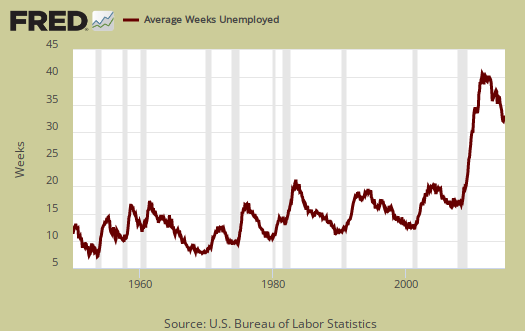
The median time one is unemployed, which means 50% of people have gotten a job in this amount of time is 11.7 weeks. A year ago the median time to be unemployed was 15.6 weeks. Notice how both the average and median yearly decline is about a month.
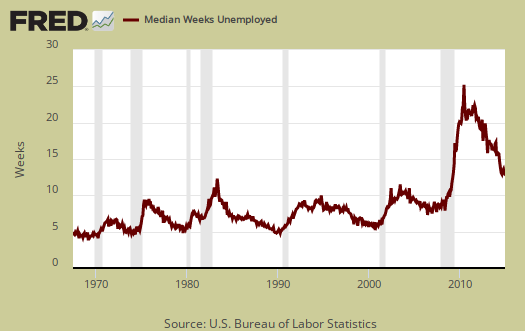
The one bad bit of this month's CPS statistics is newly unemployed increased by 241,000. It's pretty clear these folks are not re-entering the labor force for those figures declined. Overall the report shows stability in the CPS, finally. For months we have seen the unemployment rate drop due to people dropping out of the workforce, not due to more people finding work. This report is a refreshing change, although as a trend, that's yet to be seen. Here are our past overviews CPS unemployment statistics, only graphs revised.

Recent comments